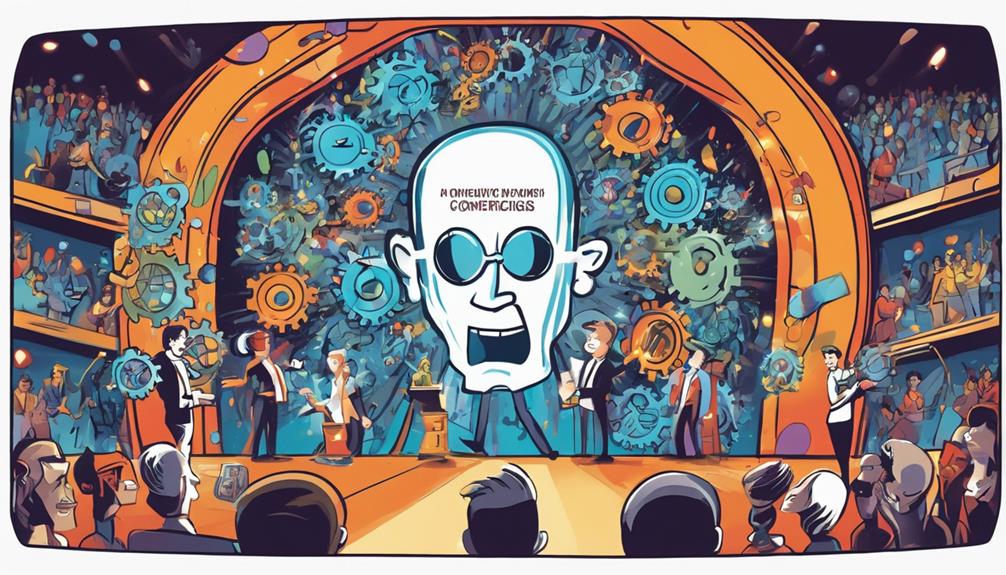Unlocking your QVC success story starts with understanding their unique market. Focus on products that resonate with QVC's loyal customer base, primarily women who value convenience. Craft compelling product submissions that clearly highlight your product's unique features and how it solves everyday problems. When presenting, engage viewers with dynamic delivery and maintain eye contact. Remember, confident and enthusiastic presentations make a lasting impression. Finally, stay aware of market trends and QVC's selection criteria to minimize risks. If you want to learn how to elevate your approach even further, there are insightful strategies waiting for you.
Key Takeaways
- Identify a unique product that addresses everyday problems and resonates with QVC's loyal customer base.
- Create a compelling demo video showcasing the product's features and benefits effectively.
- Engage viewers during presentations with dynamic delivery and clear explanations, avoiding jargon.
- Understand QVC's selection criteria and market trends to ensure your product fits their programming.
Understanding QVC's Unique Market
Understanding QVC's unique market means recognizing its loyal customer base, which primarily consists of women who value the convenience of interactive shopping from home.
These customers appreciate the engaging experience QVC offers, making them more likely to respond positively to innovative products.
You'll want to highlight features that resonate with this demographic, such as ease of use and time-saving benefits.
Additionally, consider how your product solves everyday problems or enhances their lifestyle.
QVC thrives on mass appeal and timely relevance, so your offering must stand out while still fitting into their programming themes.
Crafting Your Product Submission

To craft a compelling product submission for QVC, focus on showcasing your product's unique features and benefits that resonate with their audience.
Start by clearly defining what sets your product apart from competitors. Highlight how it solves everyday problems or fulfills specific needs. Use engaging visuals and concise descriptions to capture attention.
Research QVC's programming themes and align your submission accordingly, emphasizing mass appeal. Be prepared to address potential questions about your product's performance and pricing.
Remember, QVC seeks items that demonstrate well, so consider including a demo video.
Presenting Effectively on QVC

Presenting effectively on QVC requires you to engage viewers with a dynamic, confident delivery that highlights your product's best features.
First, know your product inside and out; familiarity breeds confidence. Use clear, concise language and avoid jargon that might confuse potential buyers.
Showcase how your product solves a problem or enhances daily life, making it relatable to viewers. Utilize visual aids to emphasize key points, and practice maintaining eye contact with the camera to create a connection.
Remember to smile and convey enthusiasm—your energy can be contagious.
Navigating Risks and Challenges

Selling on QVC comes with significant inventory risks that can strain your finances if products don't sell as expected. You'll need to invest heavily upfront, and if your items don't fly off the shelves, you could face considerable losses.
Understanding QVC's customer preferences is essential; competition is fierce, with many entrepreneurs vying for the same attention. You must guarantee your product meets their strict selection criteria, which often focus on price points and market fit.
Additionally, you'll need to manage your airtime effectively and prepare for potential returns. Staying adaptable and informed about market trends can help mitigate these challenges and position your offerings for success in this dynamic environment.
Inspiring Young Entrepreneur Stories

Young entrepreneurs are redefining success with innovative ideas and determination, proving that age is no barrier to achieving great things. You can draw inspiration from their journeys and realize that with the right mindset, anything is possible. Here are a few standout stories:
| Entrepreneur | Achievement | Age |
|---|---|---|
| Austin Russell | Youngest self-made billionaire | 25 |
| Victoria Carroll | $250,000 annual income from Fiverr | 30 |
| Moziah Bridges | Owns Mo's Bows, a bow tie company | 18 |
| Ben Pasternak | Created a successful app at 15 | 20 |
These stories highlight the potential within yourself and the countless opportunities available through platforms like QVC. Your success story could be next! We have seen entrepreneurs and small business owners thrive after launching their products on QVC, reaching a wider audience and experiencing an increase in sales. With the right product launch strategies, you can take advantage of these opportunities and see your business grow. Don’t let your potential go to waste – explore the possibilities and make your mark on the QVC platform.
Employee Engagement Strategies

Effective employee engagement strategies are essential for fostering a motivated workforce that drives organizational success and innovation.
To engage your team, start by promoting open communication—encourage feedback and suggestions to make everyone feel valued.
Recognize achievements, both big and small, to boost morale and motivation.
Implement professional development opportunities that align with employees' goals, showing you care about their growth.
Foster a sense of community through team-building activities, which can strengthen relationships and enhance collaboration.
Finally, create a positive work environment by prioritizing work-life balance and flexibility, ensuring your team feels supported.
Leveraging Performance Psychology

Leveraging performance psychology can greatly enhance your ability to present products on QVC by boosting your confidence and focus during live broadcasts. By understanding your mindset and applying psychological strategies, you can improve your on-air presence and engage your audience more effectively.
| Strategy | Benefits |
|---|---|
| Visualization | Enhances confidence and clarity |
| Positive Self-Talk | Reduces anxiety and builds focus |
| Goal Setting | Creates motivation and direction |
Utilizing these techniques can help you stay calm under pressure and deliver compelling presentations. Embrace these strategies to release your potential and connect with viewers, turning every appearance into a success story.
Conclusion
Ready to turn your dreams into reality on QVC?
Remember, 82% of QVC shoppers are women, highlighting the importance of connecting with this loyal audience. By understanding their preferences and crafting your submission thoughtfully, you can stand out in this vibrant marketplace.
Embrace the journey, showcase your passion, and prepare to engage with millions of enthusiastic shoppers. With the right strategy, your product could be the next big hit on QVC. In order to make your product a success on QVC, it’s important to understand the market and position your product in a way that appeals to potential customers. As you work towards this goal, consider finding a side hustle for steady income to support your efforts. Whether it’s freelancing, consulting, or a part-time job, having a stable source of income will allow you to focus on growing your product without financial stress. With hard work, determination, and the right approach, your product could become a household name.
Immerse yourself and let your success story unfold!









